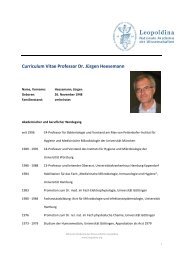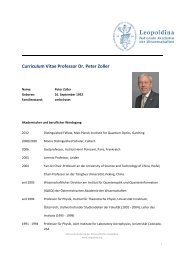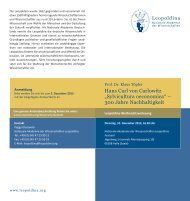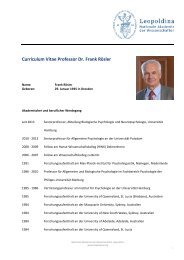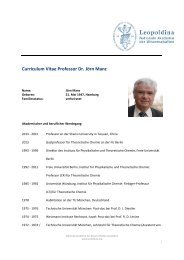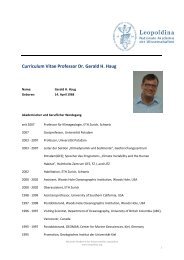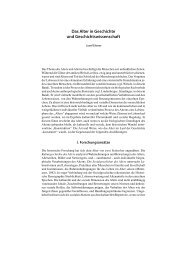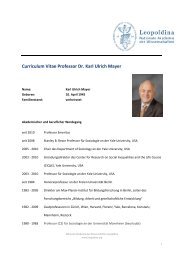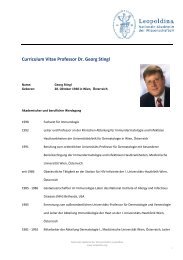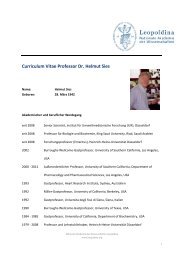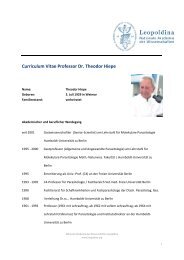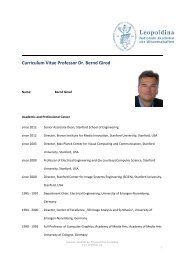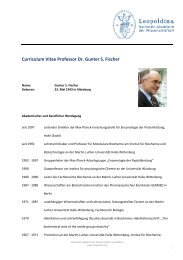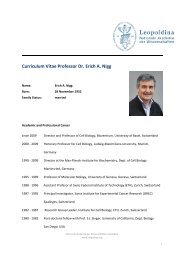Neu gewählte Mitglieder 2009 (pdf) - Leopoldina
Neu gewählte Mitglieder 2009 (pdf) - Leopoldina
Neu gewählte Mitglieder 2009 (pdf) - Leopoldina
Sie wollen auch ein ePaper? Erhöhen Sie die Reichweite Ihrer Titel.
YUMPU macht aus Druck-PDFs automatisch weboptimierte ePaper, die Google liebt.
Prof. Ph.D.<br />
George Michael Coupland<br />
*20 th December 1959 Dumfries (UK)<br />
Section: Organismic and Evolutionary Biology<br />
Matricula Number: 7259<br />
Date of Election: 29 th April <strong>2009</strong><br />
George Coupland is currently a Director of the Max<br />
Planck Institute (MPI) for Plant Breeding Research in<br />
Cologne. He leads the department of Plant Developmental<br />
Biology. He received an Honours degree in Microbiology from the University<br />
of Glasgow (UK) in 1981. His doctoral work was in the Department of Molecular<br />
Biology, University of Edinburgh (UK), where he studied the mechanisms of<br />
conjugation in bacteria. In 1985, he received a Royal Society Fellowship and an<br />
EMBO Fellowship to carry out post-doctoral research at the University of Cologne<br />
in the department of Peter Starlinger. There he developed methods to analyze the<br />
function of maize transposable elements in transgenic tobacco plants. In 1989, he<br />
returned to the UK and began his own group at the newly formed John Innes Centre<br />
in Norwich (UK).<br />
Between 1989 and 2001, the Coupland lab developed Arabidopsis as a model<br />
system to study the seasonal control of flowering by environmental cues. The group<br />
was among the first to isolate genes that regulate flowering time and those required<br />
for plant circadian clock function. This led to an influential model of how plants<br />
detect seasonal changes in day length. He was appointed a Director at the MPI for<br />
Plant Breeding Research in 2001. There his group has demonstrated the multiple<br />
regulatory layers of transcriptional and post-translational regulation that contribute<br />
to day length measurement. They have also studied the function of flowering<br />
pathway components in different organs of the plant, leading to the identification<br />
of a systemic signal transmitted from the leaves to the apex where it induces flower<br />
development. Recently they have studied how these pathways evolve to confer differences<br />
in flowering behaviour between annual and perennial species.<br />
Publications (Selection):<br />
– Corbesier, L., Vincent, C., Jang, S., Fornara, F., Fan, Q., Searle, I., Giakountis, A., Farrona,<br />
S., Gissot, L., Turnbull, C., and Coupland, G.: FT protein movement contributes to long-distance<br />
signalling in floral induction of Arabidopsis. Science 316, 1030 –1033 (2007)<br />
– Fornara, F., Panigrahi, K. C. S., Gissot, L., Sauerbrunn, N., Rühl, M., Jarillo, J., and Coupland,<br />
G.: Arabidopsis DOF transcription factors act redundantly to reduce CONSTANS expression<br />
and are essential for a photoperiodic flowering response. Developmental Cell 17, 75 – 86 (<strong>2009</strong>)<br />
– Wang, R., Farrona, S., Vincent, C., Joecker, A., Schoof, H., Turck, F., Alonso-Blanco, C.,<br />
Coupland, G., and Albani, M.: PEP1 regulates perennial flowering in Arabis alpina. Nature 459,<br />
423 – 427 (<strong>2009</strong>)<br />
21



